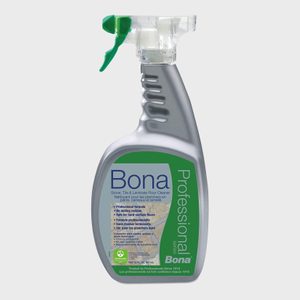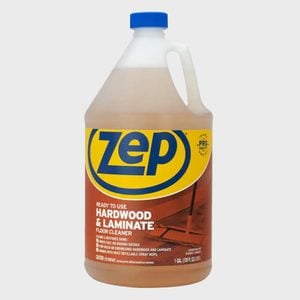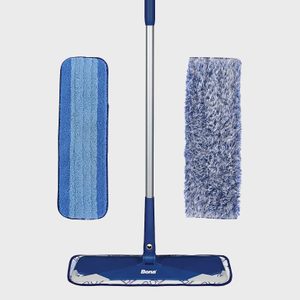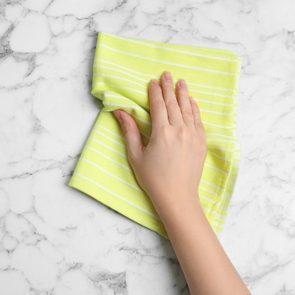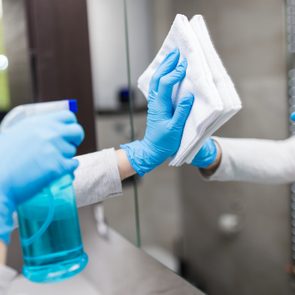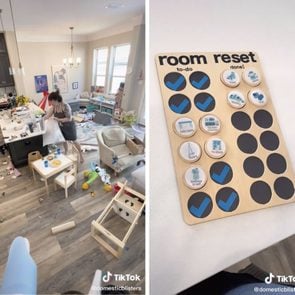How to Clean Laminate Floors So They Shine
Updated: Mar. 13, 2024
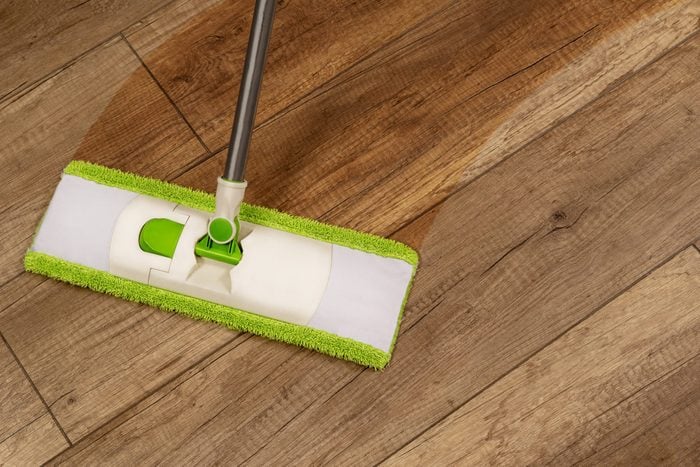
Laminate is a popular flooring material, but cleaning it requires special care. Learn how to clean laminate floors the right way with these expert tips.
Our editors and experts handpick every product we feature. We may earn a commission from your purchases.Learn more.
Thanks to their low cost, durability and wide variety of styles, laminate flooring is a popular option in many modern homes. Laminate floors are made of several layers of synthetic materials, topped by an image layer that often resembles wood or tile. And while the top layers may look like wood or tile, they shouldn’t be cleaned the same way. This is why homeowners tend to be in the dark when it comes to knowing how to clean laminate floors.
“Floors are one of the least-favorite things for people to clean,” says Pam Clyde, owner of BritLin Cleaning in Round Rock, Texas. “And it is definitely the area that gets dirty the fastest, especially if a household has pets and children.”
While the proper cleaning technique is more involved than a quick swipe of a Swiffer (you shouldn’t be wet-mopping a laminate floor), knowing how to clean laminate floors properly will help keep them in good shape for years to come. Want to add floor cleaning to your cleaning schedule? Whether you’re learning the best way to clean your kitchen or how to clean a bathroom, laminate requires a specific know-how. Follow our step-by-step advice and your laminate flooring will shine.
On This Page
How often should you clean laminate floors?
Your cleaning schedule depends on how dirty your floors get. Experts recommend vacuuming or dry-mopping laminate floors daily (the perfect task for the best robotic vacuums), and mopping and immediately drying laminate floors weekly—more often for high-traffic areas. “Most people clean their floors well enough to get by,” says Liz Trotter, owner of American Maid Service in Olympia, Washington. “But it’s not just a quick wipe, especially if your floor gets a lot of dirt tracked in.”
Not cleaning often enough risks more than just a dirty floor. “Dirt is very abrasive, and when your floor gets damaged, it’s harder and harder to clean,” Trotter says. For that reason, you should stick to a weekly cleaning schedule, rather than waiting until floors are visibly dirty or feel sticky or tacky.
Why are laminate floors hard to clean?
Moisture is the enemy of laminate floors, says Clyde. The same thing that makes laminate floors so easy to install also makes them difficult to clean. Laminate floors click and lock into place without glue or fasteners to hold them down. They are often described as “floating” above a subfloor. This construction is not watertight. If you wet-mop or steam-clean a laminate floor (or spill liquid on it), the moisture can cause damage.
Because laminate, unlike wood, doesn’t breathe, moisture will stay inside the flooring, rotting it and allowing bacteria and mold to grow. This is why the North American Laminate Flooring Association (NALFA) cautions against using “any type of cleaner that works by excessive amounts of liquid or uses steam.” NALFA also advises against using waxes or polishes, as they will form a film on the floors over time. Additionally, laminate floors should not be refinished, as they are not solid wood.
Clyde recommends always checking the product label and manufacturer’s recommendations to ensure the product is safe for use on laminate floors—she has seen some TikTok cleaning hacks that “could damage your floors.” Even a natural cleaning solution, such as white vinegar, can cause damage due to its acidity, Clyde says.
How to clean laminate floors
One thing is certain: You want to start with a well-vacuumed surface to remove any loose debris and get rid of dust. After thoroughly vacuuming the floor with an expert-approved vacuum (Clyde likes Shark brand vacuums with the roller brush turned off), gather the rest of your supplies. Beyond the proper cleaning solution, you also want to use the proper mop, something that can apply a solution damp, but not wet, says the NALFA. Stay away from abrasive sponges or pads, and no string mops, as they can hold too much water. A microfiber mop or cloth is best.
Supplies:
- Bona Pro Series Hard Surface Floor Cleaner
- Zep Hardwood and Laminate Floor Cleaner
- Dr. Bronner’s Sal Suds Biodegradable Cleaner
- Spray bottle
- Bona Premium Microfiber Mop for Multi-Surface Floors (ideally one wet, one dry)
- Extra microfiber pads
Directions:
- Choose your laminate-specific cleaning product and prepare it as stated on the package. Remember that some products may need to be diluted. If diluting, use cold to lukewarm water, Clyde says, as hot water may cause the cleaning agent to evaporate too quickly.
- Transfer to a spray bottle.
- Spray the flat mop head with just enough cleaner to moisten it. Do not spray directly on the floor.
- Start at the furthest point away from you and work in one small section, such as a 3-by-3-foot square, at a time.
- Move the mop in an S-shaped pattern, rotating the mop head at each curve so that you’re always moving any dirt or debris forward, not simply pushing it back and forth.
- After completing a section, use a dry mop or dry microfiber cloth to dry the space in the same pattern. This will work better than paper towels.
- Repeat until the entire floor is clean.
- Change your mop pads at regular intervals as they get dirty. “At some point they get so dirty, all you’re doing is smearing things around,” she says.
Pro tip: To preserve their cleaning power, learn how to wash microfiber cloths correctly. Clyde suggests washing microfiber mop pads separately from any other laundry. Do not use fabric softener or dryer sheets, which can leave a film that may transfer to the floor the next time you clean it.
How to deep-clean laminate floors
Luckily, laminate floors have a protective coating, so they are harder to stain than other kinds of flooring. The best way to deep-clean laminate floors is the same as above. You’ll just want to repeat the steps as many times as necessary. In general, you don’t want to use harsh chemicals, abrasive products or steam/water on laminate floors, even if you believe they’ll deep-clean better.
The best laminate floor cleaners
How to keep laminate floors clean
Floors are going to get dirty. And while there is no real substitute for regular, proper cleanings, removing shoes in the house can help cut down on the dirt that’s tracked in. Clyde even wears washable shoe covers because she says that even going barefoot can degrade floors, as the natural oils in the skin of your feet can affect laminate flooring over time.
While laminate floors are fairly durable and can be easier than cleaning hardwood floors, you’ll want to wipe up any spills quickly to avoid moisture getting in between the boards. If your laminate floors are certified by NALFA, they are likely protected by an extensive warranty against stains, fading and moisture damage. And luckily, similar to cleaning baseboards and cleaning carpets, knowing how to clean laminate floors the right way is actually quite simple and can go a long way in extending the life of your flooring.
Sources:
- North American Laminate Flooring Association: “What’s Not to Like about Laminate Flooring?”
- Pam Clyde, owner of BritLin Cleaning
- Liz Trotter, owner of American Maid Service





















